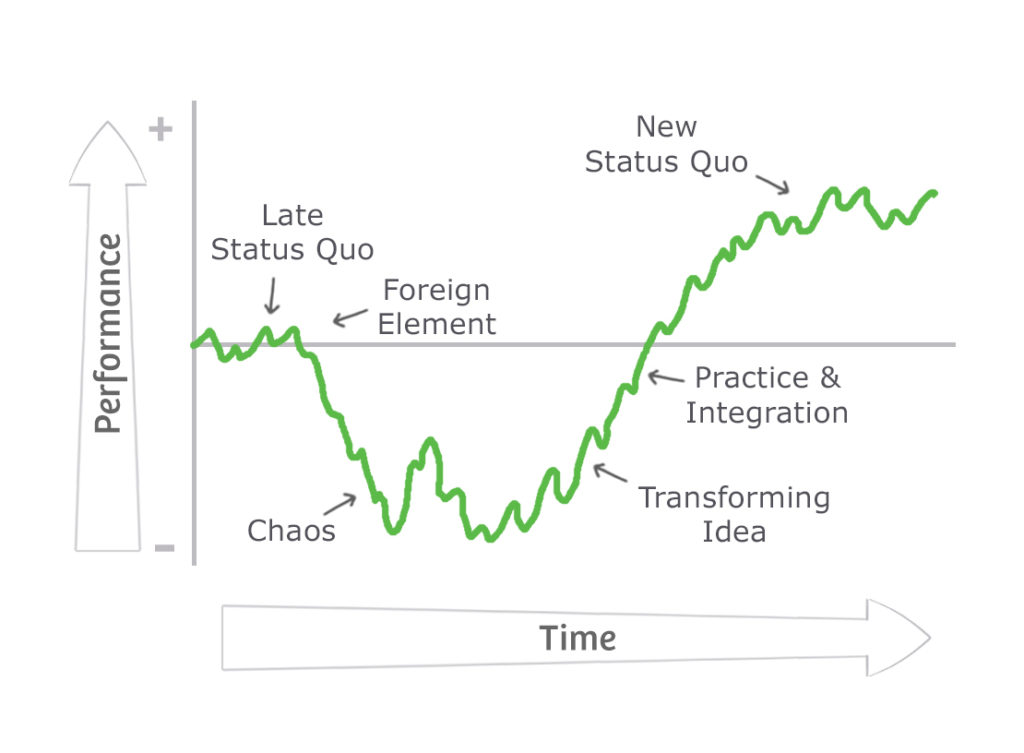What It Is:
The Satir Change Model, also known as the Satir Growth Model, was developed by Virginia Satir, a well-known American psychotherapist and family therapist. The model is designed to illustrate the process of individual and organizational change, emphasizing the emotional and psychological aspects of the change journey. Virginia Satir was a pioneer in family therapy and made significant contributions to the field of human psychology.
Key Stages of the Satir Change Model:
- Late Status Quo:
- This stage represents the initial state before the change process begins. In this phase, individuals or organizations are operating within their existing structures and processes.
- Resistance:
- The Resistance stage involves discomfort and resistance to change. Individuals may experience fear, uncertainty, and anxiety about the upcoming changes. Resistance is a natural response to the disruption of the familiar.
- Chaos:
- Chaos is a stage where the old ways of doing things have been disrupted, and new approaches are being explored. It’s a period of confusion and uncertainty, but it is also an opportunity for creativity and innovation.
- Integration:
- In the Integration stage, individuals or organizations start to make sense of the changes. New structures and processes are established, and a sense of stability and understanding begins to emerge.
- New Status Quo:
- The New Status Quo marks the establishment of a new and more stable state. Individuals or organizations have successfully navigated the change process and are functioning within the updated context.
How to Use It:
Using Satir Change Model in Agile Coaching:
- Understanding Emotional Responses:
- Acknowledge and address the emotional responses that individuals may experience during the change process. Understanding and managing emotions is crucial for successful change implementation in Agile teams.
- Navigating Resistance:
- Recognize that resistance is a natural part of the change process. Work collaboratively with the team to understand concerns, provide support, and communicate the benefits of the proposed changes.
- Embracing Chaos as an Opportunity:
- During the Chaos stage, encourage a mindset shift to view chaos as an opportunity for innovation and creativity. Facilitate brainstorming sessions and collaborative problem-solving to explore new possibilities.
- Supporting Integration:
- Provide support and resources to help individuals and teams integrate the changes effectively. This may involve training, coaching, and creating a supportive environment for learning and adaptation.
- Communicating the Vision:
- Clearly communicate the vision and objectives behind the changes. Ensure that everyone understands the purpose and benefits of the changes to foster a shared commitment to the new direction.
Understanding the Satir Change Model can enhance an Agile coach’s ability to navigate and facilitate change within software delivery teams, especially considering the emotional and psychological aspects that often accompany change processes.
References:
- Books by Virginia Satir:
- Virginia Satir authored several books on family therapy and personal development. Exploring her works, such as “The New Peoplemaking” and “Conjoint Family Therapy,” can provide deeper insights into her theories, including the Satir Change Model.
- Training in Family Therapy and Change Management:
- Courses and training programs in family therapy or change management may cover the Satir Change Model. Consider enrolling in relevant workshops or seeking out trainers with expertise in Satir’s work.
- Psychology Journals and Publications:
- Research articles and publications in psychology journals may delve into the Satir Change Model. Academic resources can provide a more in-depth understanding of the model’s theoretical foundations.
- Psychotherapy and Counseling Associations:
- Professional associations in psychotherapy and counseling may offer resources and publications related to Virginia Satir’s work. Check websites or publications from organizations such as the American Association for Marriage and Family Therapy (AAMFT).
Visit the Agile Coach’s Toolkit for more definitions, models, theorems and stuff.

